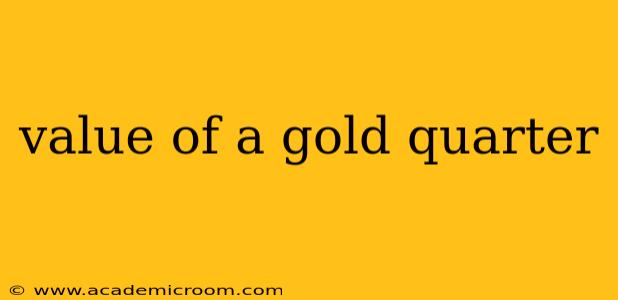The phrase "gold quarter" can be a bit misleading. It doesn't refer to a standard US quarter made of gold. Instead, it usually points to one of two possibilities: a quarter made of gold during a specific historical period or a modern commemorative coin designed to look like a quarter but made of gold. Let's explore both scenarios to understand how to determine the value.
What Makes a Gold Quarter Valuable?
The value of a gold quarter hinges primarily on these factors:
- Gold Content: The weight and purity (karat) of the gold are paramount. Higher karat gold (24 karat being pure gold) signifies a greater value. You'll need to determine the exact gold content to calculate its worth accurately.
- Year and Mint Mark: The year of minting and the mint mark (a small letter or symbol indicating where the coin was minted) can significantly impact value for historical gold coins. Rare mintages or dates command higher prices among collectors.
- Condition: The condition of the coin, graded on a scale by professional grading services (like PCGS or NGC), is crucial. Scratches, dents, and wear all affect value. A near-perfect coin in "Mint State" condition will be worth considerably more than a heavily worn example.
- Demand: Like any collectible item, demand from collectors plays a role. A coin in high demand will fetch a premium price.
Is it a Historical Gold Quarter or a Modern Commemorative?
This is the first question you need to answer.
-
Historical Gold Quarters: The United States has never minted a standard circulation quarter made entirely of gold. However, some historical gold coins existed in the past that were of similar size or denomination to a quarter. Determining their value requires professional numismatic appraisal.
-
Modern Gold Commemorative "Quarters": Many private mints produce gold coins that are designed to resemble a US quarter but are clearly marked as commemoratives or bullion coins. Their value is primarily determined by their gold content and weight.
How to Determine the Value of Your "Gold Quarter"
-
Identify the Coin: Carefully examine the coin. Is it clearly marked as a commemorative piece? Does it have any markings indicating its gold content (e.g., karat)? Take high-quality photos of both sides, including close-ups of any markings.
-
Weigh the Coin: Using a precise scale, weigh the coin in grams. This is crucial for determining the gold content and subsequent value.
-
Determine the Gold Purity: If the coin is marked with a karat, that's a good start. Otherwise, you may need professional assaying to determine the gold's purity. This involves testing a small sample of the coin to ascertain the exact gold content.
-
Check Online Marketplaces and Databases: Once you have the weight and purity, you can research the current gold price per gram or ounce. Look at online marketplaces like eBay (paying attention to sold listings, not just asking prices) for similar coins to get an idea of their market value. Numismatic databases can also provide additional information on historical coins.
-
Consult a Professional Numismatist: For historical coins or those of uncertain origin, consulting a professional numismatist is highly recommended. They can accurately assess the coin's authenticity, condition, and value.
Frequently Asked Questions (PAA)
Q: How much is a gold-plated quarter worth?
A: A gold-plated quarter is worth very little more than a regular quarter. Gold plating is a thin layer of gold applied over another metal, usually copper-nickel. The actual gold content is minimal and doesn't add significant value.
Q: How can I tell if a quarter is made of gold?
A: A genuine gold coin will be significantly heavier than a standard quarter. It may also have markings indicating the gold content (karat) and the year/mint mark. If you suspect it's gold, you should have it professionally tested.
Q: Where can I sell a gold quarter?
A: You can try selling a gold quarter through online marketplaces like eBay, through coin dealers, or at a pawn shop. However, be aware that different vendors will offer varying prices, and it is recommended to do your research to ensure a fair price.
Q: Are there any gold quarters from a specific year that are worth more?
A: As explained above, the U.S. has not produced circulation quarters from gold. If you have a coin you believe might be valuable, determining its origin and contacting a professional numismatist is crucial. The historical context and condition drastically impact worth.
Remember, always exercise caution when buying or selling gold coins. Be wary of scams and ensure you're dealing with reputable dealers. This information is for general guidance only and does not constitute financial advice. Always consult with relevant professionals for any specific valuation or selling advice.
